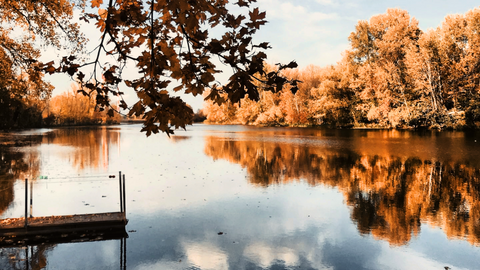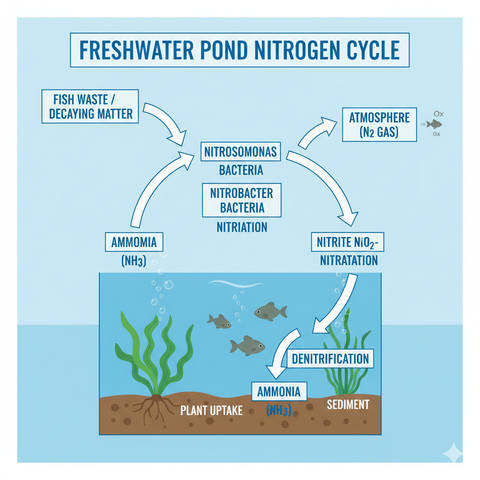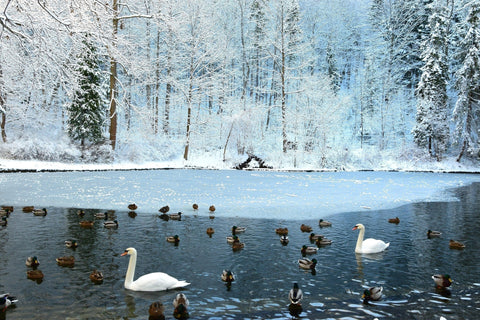Introduction: Preparing Your Pond for the Cold Months
As temperatures drop, your pond’s ecosystem begins to slow down. Beneficial bacteria work more slowly, oxygen levels change, and organic debris from leaves and fish waste starts to accumulate on the bottom. Without proper care, that buildup can lead to cloudy water, odors, and a tough spring recovery.
That’s where UltraClear Autumn Prep and UltraClear Winter Blend come in — two cold-weather biological treatments designed to help your pond rest easy through winter and return balanced and clear when spring arrives.
Why Fall Prep Matters
Autumn is the most important time to prepare your pond for the dormant season. The goal isn’t to “shut down” your pond — it’s to keep biological activity steady enough to prevent sludge and debris from building up.
By addressing waste before it freezes, you reduce spring cleaning work, protect fish health, and maintain better clarity through the coldest months.
Key reasons to treat before winter:
- Organic debris breaks down slowly in cold water, creating sludge that feeds algae later.
- Uneaten food and leaf matter release nutrients that cloud water come spring.
- Healthy bacteria populations going into winter stabilize oxygen and nitrogen balance.
Use UltraClear Autumn Prep in Late Fall
Best time to apply: When daily water temperatures drop below 60°F, typically in late September through November depending on your region.
Purpose: Autumn Prep delivers cold-tolerant beneficial bacteria and natural enzymes that continue breaking down organic waste even as the water cools.
How to use:
- Dose rate: Apply 3 cups per quarter surface acre of pond water. For heavily loaded ponds, double the first two doses. Try to dose at least three times before the first freeze.
- Frequency: Treat every 1–2 weeks until water temperatures are consistently cooler than 40F.
- Application: Disperse evenly across the pond surface or around areas with visible sludge or leaf buildup.
- Filtration note: Keep filters and aeration running as long as possible to circulate oxygen and bacteria.
Why it works: UltraClear Autumn Prep’s cold-weather microbes remain active down to near-freezing temperatures. By digesting leftover nutrients before winter dormancy, they help maintain biological balance and minimize “spring shock.”
Transition to UltraClear Winter Blend
Best time to start: Once water temperatures stay between 35-40°F and ice begins forming at the edges.
Purpose: Winter Blend maintains essential biological activity under ice cover, reducing the risk of anaerobic buildup and supporting water quality until spring thaw.
How to use:
- Dose rate: Apply 1 ounce per 1,000 gallons monthly through winter, or until ice fully covers the pond.
- Aeration tip: If possible, run an air stone or small de-icer to keep a small opening for gas exchange.
-
Reapply after thaw: As soon as temperatures rise above 55°F, resume biweekly warm weather UltraClear pond care routine.
Why it works:
Winter Blend contains strains of beneficial bacteria selected for low-temperature resilience. Even in near-dormant conditions, they help stabilize your pond’s nitrogen cycle, reducing harmful gases and keeping water cleaner beneath the ice.
Pro Tips for Fall and Winter Pond Care
- Skim leaves early: The less debris that settles, the less work bacteria must do later.
- Feed fish lightly: Stop feeding once water consistently stays below 50°F — digestion slows dramatically.
- Test water before freeze: Balanced pH and low ammonia support bacterial efficiency through winter.
-
Store products properly: Keep UltraClear treatments in a frost-free, indoor location to preserve live cultures.
A Season of Stewardship
Preparing your pond for winter isn’t just maintenance, it’s stewardship. Autumn Prep and Winter Blend work together to keep your ecosystem healthy, protect aquatic life, and ensure that when spring returns, your pond is ready to thrive again.



